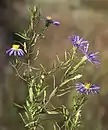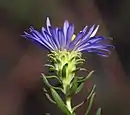| Symphyotrichum oblongifolium | |
|---|---|
 | |
| Scientific classification | |
| Kingdom: | Plantae |
| Clade: | Tracheophytes |
| Clade: | Angiosperms |
| Clade: | Eudicots |
| Clade: | Asterids |
| Order: | Asterales |
| Family: | Asteraceae |
| Tribe: | Astereae |
| Subtribe: | Symphyotrichinae |
| Genus: | Symphyotrichum |
| Subgenus: | Symphyotrichum subg. Virgulus |
| Section: | Symphyotrichum sect. Grandiflori |
| Species: | S. oblongifolium |
| Binomial name | |
| Symphyotrichum oblongifolium | |
 | |
| Native distribution[3] | |
| Synonyms[2] | |
|
Basionym
Alphabetical list
| |
Symphyotrichum oblongifolium (formerly Aster oblongifolius), commonly known as aromatic aster[4] or oblong-leaved aster,[3] is a species of flowering plant in the family Asteraceae and is native to parts of the eastern and central United States. It is an uncommon herbaceous perennial[5] that reaches heights of 10–80 centimeters (4–31 inches) and blooms August–November with many flower heads in various shades of purple.[3]
Description
Aromatic aster is a perennial, herbaceous flowering plant that reaches heights of 10–80 centimeters (4–31 inches) on one to ten or more stems growing from a sturdy caudex. It blooms August–November with many flower heads in various shades of purple.
Distribution and habitat
Aromatic aster is found in parts of Kansas,[6] Ohio, northern Illinois, hilly parts of southern Illinois, and on the banks of the Mississippi River and Illinois River,[7] as well as other parts of the central United States. It is found in Missouri, along the Ohio River,[4] and from Pennsylvania to Nebraska to Minnesota to Virginia.[8]
Conservation
As of July 2021, NatureServe listed Symphyotrichum oblongifolium as Secure (G5) worldwide; Critically Imperiled (S1) in Colorado and North Carolina; Imperiled (S2) in Wyoming; and, Vulnerable (S3) in Indiana and Ohio.[1]
Citations
References
- Britton, N.L.; Brown, A. (1970). An Illustrated Flora of the Northern United States and Canada. Vol. 3. Dover Publications. p. 366. Retrieved 3 December 2009.
- Brouillet, L.; Semple, J.C.; Allen, G.A.; Chambers, K.L.; Sundberg, S.D. (2006). "Symphyotrichum oblongifolium". In Flora of North America Editorial Committee (ed.). Flora of North America North of Mexico (FNA). Vol. 20. New York and Oxford: Oxford University Press. Retrieved 10 September 2021 – via eFloras.org, Missouri Botanical Garden, St. Louis, MO & Harvard University Herbaria, Cambridge, MA.
- Burns, J. (January 1983). "Aster Oblongifolius Nutt. Shale Barren Aster" (PDF). Ohio Department of Natural Resources. Archived from the original (PDF) on 11 May 2009. Retrieved 1 December 2009.
- Haddock, M. (2018). "Aromatic aster". Kansas Wildflowers and Grasses. Retrieved 13 August 2018.
- Hilty, J. (2020). "Aromatic Aster Symphyotrichum oblongifolium Aster family (Asteraceae)". Illinois Wildflowers (www.illinoiswildflowers.info). Retrieved 5 July 2021.
- NatureServe (2 July 2021). "Symphyotrichum oblongifolium Aromatic Aster". explorer.natureserve.org. Arlington, Virginia. Retrieved 5 July 2021.
- POWO (2019). "Symphyotrichum oblongifolium (Nutt.) G.L.Nesom". Plants of the World Online. Royal Botanic Gardens, Kew. Retrieved 5 July 2021.
- USDA, NRCS (2014). "Symphyotrichum oblongifolium". The PLANTS Database (plants.usda.gov). Greensboro, North Carolina: National Plant Data Team. Retrieved 6 December 2015.
External links
- Missouri Plants
- Petersen, Roger Tory; McKenny, Margaret (1998). A Field Guide to Wildflowers: Northeastern and North-central North America. Houghton Mifflin Harcourt. p. 358.








